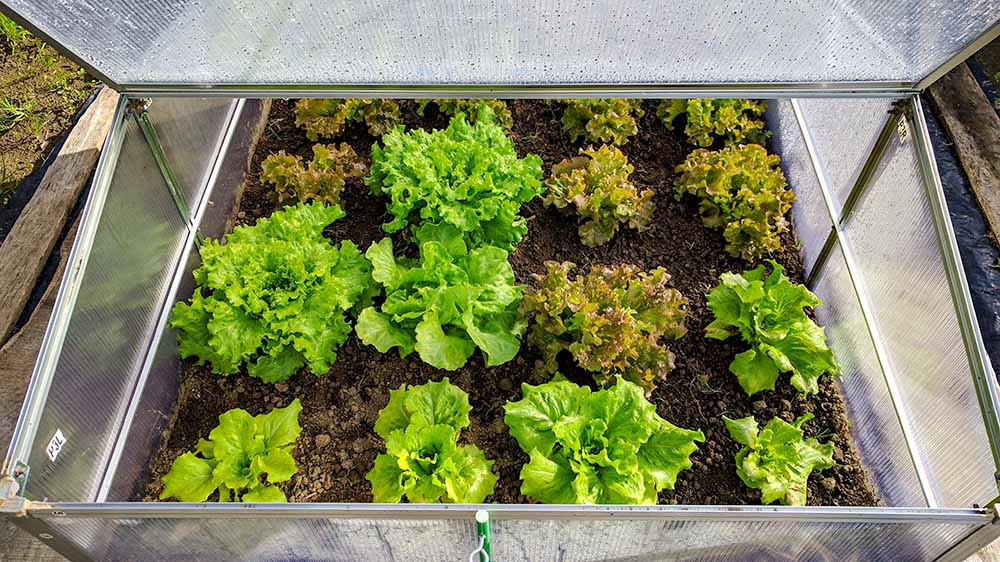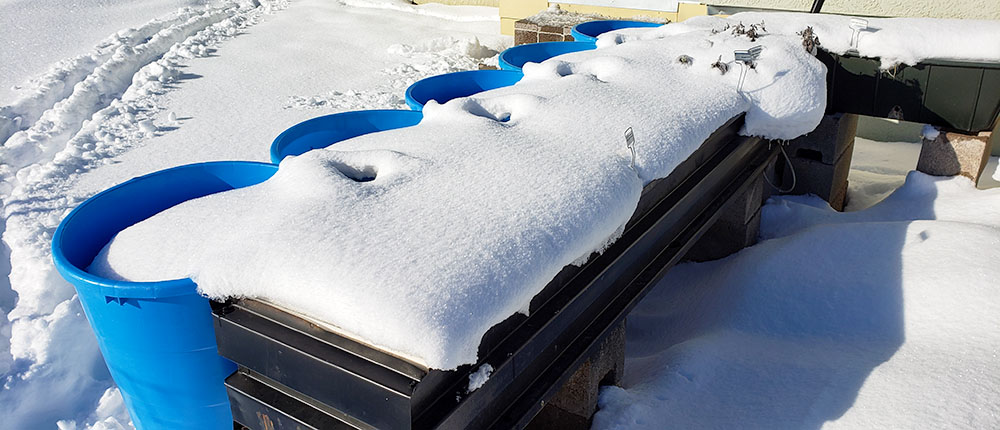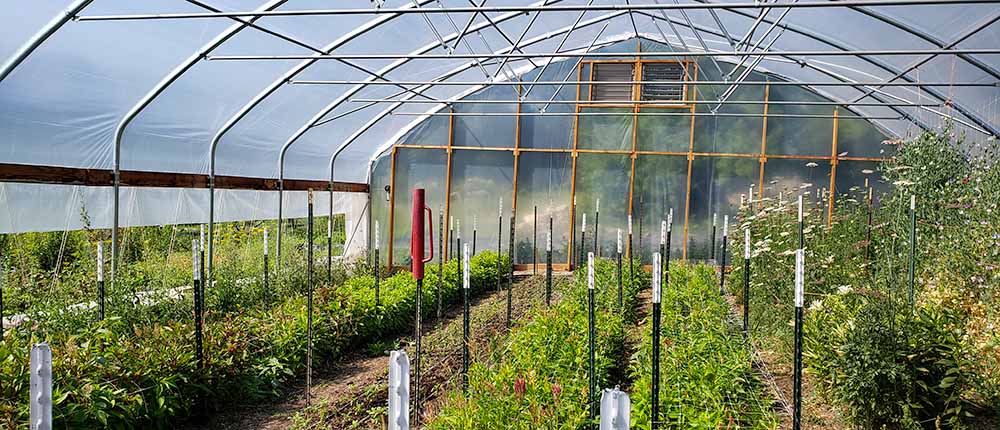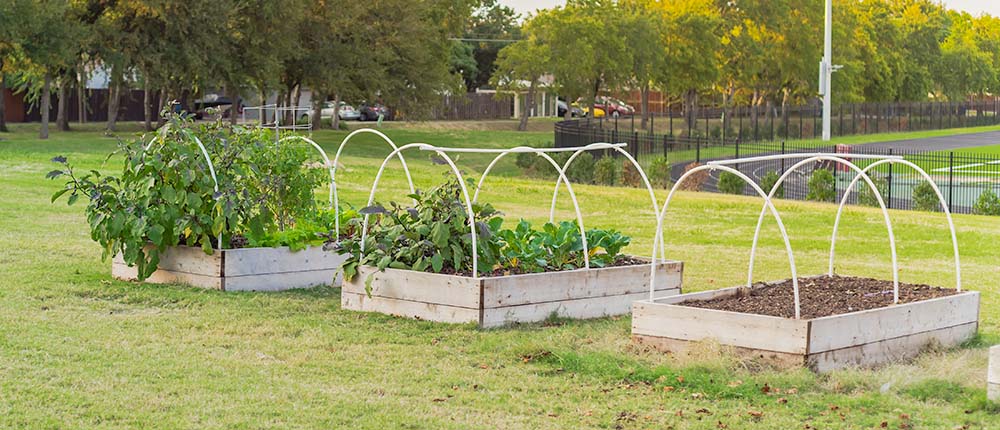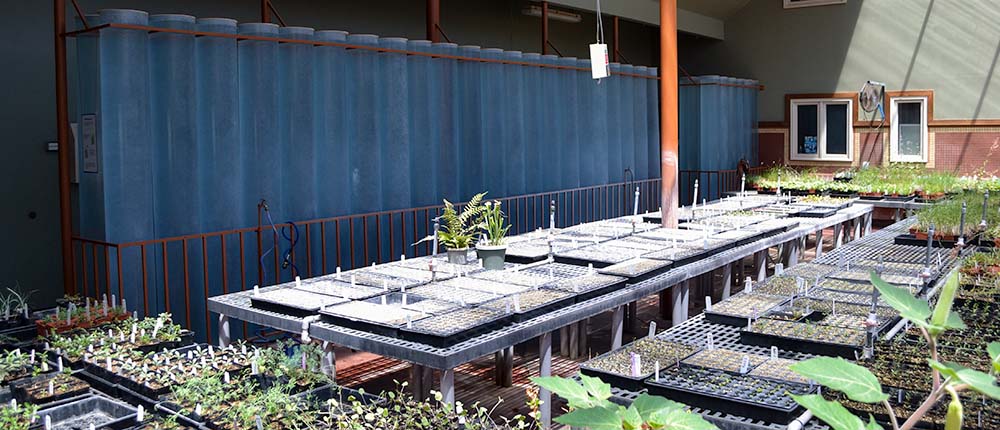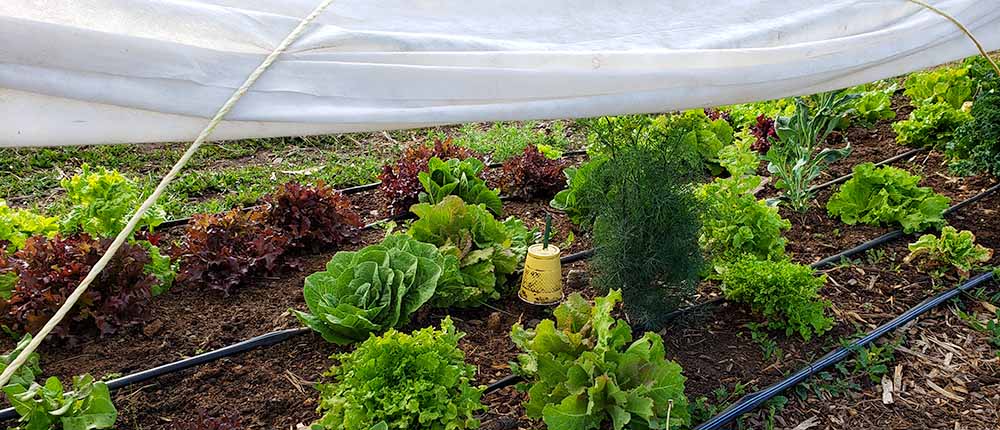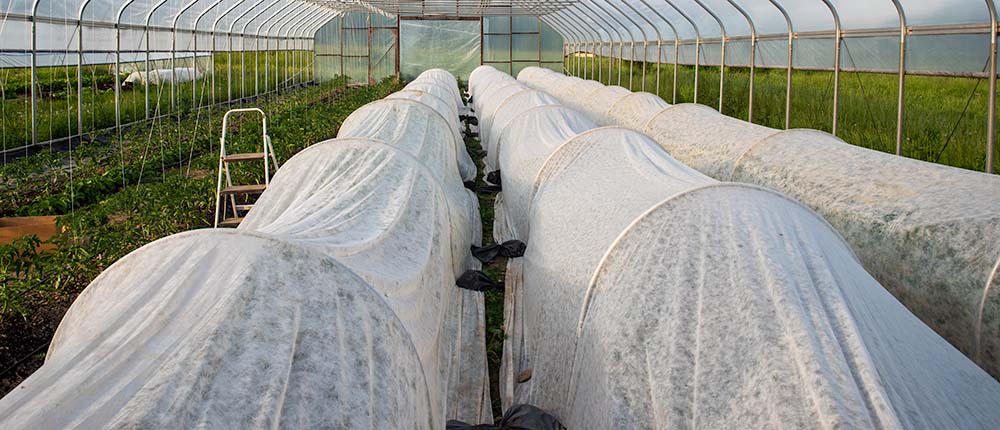Garden Season Extension
Simple Techniques for Longer Harvests
Season extension uses strategic approaches to create microclimates that protect your plants from cold temperatures, frost, and other harsh weather conditions. These mini-environments trap warmth and shield plants from the elements, allowing you to continue growing a surprising amount of vegetables and herbs earlier than you thought possible in early spring and long after the first frost in fall.
Season extension isn’t about defying nature but about working with it. By understanding your plants’ needs and providing extra protection, you can stretch your gardening season—spring and fall—and enjoy fresh produce for longer than you ever thought possible. It’s a simple concept with enormous benefits: extending your harvest, increasing your yield, and broadening the variety of crops you can grow.
Season extension is easy to do whether you have a traditional backyard garden, raised beds, or a few containers on a balcony. Simple and inexpensive methods like cloches and row covers can significantly boost your harvest. More elaborate techniques like hoop houses and greenhouses offer greater flexibility and protection.
We’ll discuss a range of options and how they work so you can choose the ones that best suit your space and gardening style.
Understanding Season Extension
What Is It?
Season extension involves stretching a typical growing season from early spring to late fall and possibly winter. From early spring, several weeks before your last frost date, to late fall and long after your first frost, many gardens can grow fresh vegetables for eight to nine months using these techniques.
The secret to fall season extension lies in creating a sheltered environment, preserving the warmth of late summer and early fall to continue growing plants well into the cooler months. It starts with planting in late summer when the soil and air temperatures are perfect for plant growth. As summer fades, the soil and air begin to cool down. You aim to capture as much of that lingering warmth as possible and hold onto it for as long as possible. This often means protecting plants from frost, insulating the soil to retain warmth, and maximizing sunlight exposure.
The key to spring season extension is capturing as much sunlight as possible within your sheltered environment, gradually warming the soil and air. Techniques like using dark-colored containers or black paper mulch that absorb sunlight and warm the soil are simple and surprisingly effective. The warm microclimate jumpstarts germination and growth for your seedlings and young plants, giving them a headstart weeks before your last frost.
The best season extension technique for your garden will vary depending on your climate.
No matter where you live, the key is to start early.
Begin your fall season extension preparations while the weather is still warm so your plants can adjust before the cold sets in. Plan your spring season extension in the fall, when it is still warm, and you can plan and build your cold frame or practice setting up row covers or cloches.
If you need help planning your cool season garden, our guide, How to Plan for Fall and Winter Gardening, has all the details you need!
For help with spring planting, Planning and Planting Your Spring Garden has what you need to have a successful season.
Dormant winter garden beds.
Why Extend Your Garden Season?
Not only does season extension supply fresh food when most gardens are dormant, but it also enhances the flavor of your crops. Cool-season vegetables, like kale, Brussels sprouts, and carrots, develop sweeter and more complex flavors when exposed to cooler temperatures. Frost triggers the plants to convert starches into sugars to protect them at lower temperatures, which acts like a natural sweetener.
Many common garden pests are less active with cool temperatures or disappear entirely. This means fewer worries about caterpillars munching on your kale or aphids attacking your lettuce and more time enjoying your garden.
One of the most overlooked benefits of extending your garden’s productivity is the simple pleasure of spending time in your garden throughout the cooler seasons. With some creativity and the proper techniques, you can create a vibrant, productive space that brings you joy and fresh produce as the seasons change.
High tunnel for season extension.
How It Works
Season extension is about creating a microclimate in your garden – a small, controlled environment that’s slightly warmer and more sheltered than the surrounding environment.
This microclimate acts as a buffer against the cold, allowing your plants to continue growing even as the temperatures drop. Think of it like a light sweater you wear when it gets nippy – just enough warmth against your skin to take the chill off without overheating.
Protecting Plants from Frost and Cold: Frost forms when a plant’s surface temperature drops near freezing. This causes the water inside the plant’s cells to freeze and expand, rupturing the cells, which damages or even kills the plant. Season extension coverings like row covers and low tunnels act as a physical barrier, protecting the plants from frost and cold winds.
The Role of Warmth and Trapped Heat: Plants need warmth for photosynthesis, which converts sunlight into energy. As the temperatures cool, this process slows down, which is why many plants stop growing in the winter. By trapping heat around your plants, you can create a warmer environment that allows them to continue photosynthesizing and growing even when cold outside.
Insulation and Microclimates: Like the insulation in your home helps keep the heat in, insulation in your garden helps keep the warmth around your plants. Materials like row cover fabric, straw, or water-filled plastic bottles act as insulation, trapping heat from the sun and slowing its escape. This microclimate is warmer than the surrounding air, allowing your plants to thrive in temperatures that would otherwise be too cold.
Retained Soil Warmth: When the soil temperature drops significantly, it slows down or stops root growth. Techniques like covering the soil with a thick layer of mulch, floating row covers, or installing low tunnels can help insulate the soil and keep it warmer. This allows the roots to continue growing, which in turn helps the plant stay healthy and productive.
The 5°F Rule: A simple rule of thumb for season extension is the 5°F rule. This means that each layer of protection you add to your plants (like a cloche, a row cover, or a low tunnel) can increase their tolerance to cold temperatures by about 5°F. So, if you have a plant that can typically withstand temperatures down to 35°F, adding a row cover might protect it down to 30°F, and adding a second layer of protection (like a row cover over the cloche) might protect it down to 25°F.
This powerful concept can help you significantly extend your growing season.
School garden hoop houses.
Simple Season Extenders for Every Garden
Now that we understand how and why to use season extension techniques, let’s look at what you can do in your garden to extend your season and harvest, starting with the simplest and easiest to use. Feel free to pick and choose, using these tools alone or together to suit your growing climate and garden size best.
Milk Jug Cloches: These DIY cloches are a classic for a reason. Simply take a clean, empty plastic milk jug (or a similar plastic container), remove the label, and cut off the bottom. Place the jug over a seedling or young plant, pushing the cut edges slightly into the soil to secure it. The jug acts like a mini-greenhouse, trapping heat during the day and protecting the plant from frost at night. It’s a simple, effective way to extend the growing season in either fall or early spring. They’re beneficial for protecting tender seedlings from early frosts in the fall.
If you don’t have milk jugs, use other clear plastic containers, such as soda or water bottles. Even glass jars can work as cloches for smaller plants. The key is to choose a container that’s clear so sunlight can reach the plant and that’s large enough to provide some space for growth.
Remove the cloches on warm, sunny days to prevent the plants from overheating. For even more protection, you can also use cloches with other season extension techniques, such as row covers or cold frames.
The one downside to cloches is the size of plants they can protect – shorter, younger seedlings or young transplants that don’t touch the walls are ideal. Once they grow taller, you’ll need to use a different protection method.
The original wall-o-water! A bank of water-filled tubes used as a thermal battery at The Aboretum in Flagstaff, AZ.
Wall-o-Water Plant Protectors: Picture a ring of connected vertical water-filled plastic tubes surrounding your plant, acting as a mini-greenhouse and thermal battery. These clever devices are especially effective at protecting heat-loving plants like tomatoes, peppers, and eggplants from the cold with a consistent source of warmth.
Wall-o-Waters are relatively simple to set up and use. Fill the tubes with water, place them around your plant, and secure them with stakes or clips. They are also relatively inexpensive and easy to set up, making them a popular choice for novice and experienced gardeners.
During the day, the water in the tubes absorbs heat from the sun, acting like a thermal battery. As the temperature drops at night, the water gradually releases the stored heat, keeping the air around the plant warmer than the surrounding environment. This creates a consistent temperature buffer that can protect your plants from light frosts and extend their growing season by several weeks.
Whether growing in raised beds, containers or directly in the ground, Wall-o-Water protectors are a simple yet effective way to extend your growing season and maximize your harvest.
Row Covers: These lightweight, breathable fabrics are another tool for extending the growing season and protecting crops. They come in two main types: floating row covers laid directly over plants and supported row covers with hoops or frames to create a low tunnel. Both types offer frost protection, but supported row covers provide more warmth and are better suited for taller plants.
Row covers are a physical barrier against frost, wind, and pests while allowing sunlight, air, and water to reach your plants. They create a microclimate by trapping heat and moisture around your plants. Plus, they moderate temperature swings and help conserve moisture in the soil, creating a more stable growing environment.
Here are a few tips for using row covers effectively:
- Secure them properly: Loose row covers can blow away in the wind, so secure the edges with rocks, soil, or landscape staples.
- Choose the right weight: Row covers come in different weights, measured in ounces per square yard. Lighter-weight fabrics (0.5-1.5 oz) offer minimal frost protection and are best used for insect control or as a season extender in mild climates. Heavier-weight fabrics (1.5-3.0 oz) provide more insulation and are best for overwintering hardy crops or providing maximum frost protection in frigid temperatures.
- Ventilate on warm days: Even with lightweight fabrics, temperatures under row covers can get too high on sunny days. Be sure to vent them by lifting the edges or using clothespins to create openings.
Row covers are an incredibly versatile tool for any gardener. You can use them on various plants, from leafy greens and root vegetables to delicate flowers. They are simple and affordable, and with a little experimentation, you can find the perfect row cover solution for your garden. You can extend your harvest well into the cooler months or allow your seedlings a significant headstart in spring.
Lettuce growing in low tunnel with the cover tied up.
Cold Frames: A cold frame is like a miniature greenhouse – a surprisingly versatile yet simple structure with a transparent top (often made of glass or plastic) that traps heat and creates a warmer environment than the outside air, allowing plants to grow even when the temperatures outside are too cold.
The top picture is a cold frame with lettuce growing in it.
They are ideal for smaller spaces like patios, balconies, or raised beds. They’re relatively inexpensive and easy to set up, making them an excellent option for beginners or gardeners looking for fresh greens in the middle of winter or early spring.
The key to using a cold frame effectively is managing the temperature inside. On sunny days, you’ll need to vent the cold frame by propping open the lid to prevent the temperature from getting too high. You can add a floating row cover or two on cold nights to boost the chill protection. On frigid nights, you may need an extra insulation layer, like a blanket or straw, to keep the plants warm.
With some care and attention, a cold frame can become a valuable tool for extending your growing season and enjoying fresh produce from your garden for months longer than you thought possible.
Mulch: Mulch is a gardener’s best friend for many reasons, and during the cooler months, it plays a crucial role in extending the season.
Mulch offers several other benefits for season extension:
- Insulation: Mulch acts as a barrier between the cold air and the soil, helping to maintain a warmer soil temperature. This allows roots to continue growing for longer, which in turn helps the plant stay healthy and productive.
- Weed Suppression: Mulch prevents weed seeds from germinating and competing with your plants for nutrients and water by covering the soil.
- Moisture Retention: Mulch helps reduce evaporation, keeping the soil moist for longer. This benefits plants, especially in the fall and winter when the air is drier, and watering may be less frequent.
- Soil Fertility: As organic mulches decompose, they add valuable nutrients to the soil, improving its fertility and structure.
When choosing mulch for season extension, consider your specific needs and climate. Straw is popular because it’s lightweight, easy to apply, and provides good insulation. Shredded leaves are another excellent option, especially if you have an abundance of them in the fall. Wood chips are longer-lasting, ideal for suppressing weeds and helping to regulate soil temperature. Compost is a fantastic mulch for adding nutrients to the soil, but it may offer less insulation than other materials.
To use mulch effectively, apply a 2-4 inches thick layer around your plants. Be sure to leave a small gap around the base of the plant to prevent rot. Remember, mulch is just one tool in your season extension toolbox. By combining mulch with other techniques like cloches, row covers, or cold frames, you can create a multi-layered approach to help your garden thrive through the colder months.
Mulch as a season extender.
Taking it to the Next Level
Low Tunnels, Hoop Houses and Greenhouses
Once you’re comfortable with the basics of season extension, you should take things up a notch and explore the world of low tunnels, hoop houses, and greenhouses. These structures offer more protection, allowing you to grow a wider variety of crops for an extended period.
Low Tunnels/Hoop Frames: Low tunnels, also known as hoop houses or hoop frames, are essentially larger versions of row covers supported by hoops. They’re relatively simple and inexpensive to construct using readily available materials like PVC pipes, rebar, or flexible tubing. The hoops are inserted into the ground and then covered with row cover fabric clipped to the hoops, creating a tunnel-like structure that protects your plants from the elements.
Low tunnels are versatile and are adaptable to different garden or container sizes and shapes. You can build them as small as a few feet wide for individual rows of plants or as large as several feet wide and long for entire raised beds.
High Tunnels/Larger Hoop Houses: High tunnels are essentially larger versions of low tunnels, with taller hoops and a more permanent structure. Unlike low tunnels, which are typically covered with row cover fabric, high tunnels usually have greenhouse-grade plastic sheeting. This creates a warmer, more controlled environment, extending the growing season even further than low tunnels. High tunnels are often semi-permanent structures that can stand for multiple seasons.
Greenhouses: Greenhouses are permanent structures designed to create a controlled environment for plants. They typically have a frame made of wood, metal, or PVC and are covered with transparent materials like glass or polycarbonate panels. Unlike low or high tunnels, greenhouses offer more sophisticated features like heating, cooling, ventilation, and even irrigation systems.
Greenhouses come in various styles, including lean-to models that attach to a house or other building, freestanding models that stand alone, and even portable models. The choice of materials for the frame and covering will depend on your budget, climate, and personal preferences.
Supported row covers inside a greenhouse.
A Garden’s Resilience
Season Extension Lessons
Season extension is more than just a gardening technique; it’s about finding your garden’s full potential by giving your plants what they need when the weather is cool.
The beauty of season extension lies in its adaptability. Whether you have a sprawling backyard garden or a few pots on a balcony, there are techniques to suit every space and skill level. Don’t be afraid to experiment and find what works best for you and your plants.
We’ve explored various techniques, from simple milk jug cloches to sophisticated greenhouses, each offering a unique approach to season extension. The best part is, you don’t have to choose just one. Feel free to experiment with different methods and find what works best for your garden, climate, and budget. There’s no right or wrong way to extend your season, only the satisfaction of finding your rhythm and reaping the rewards.
Additional Resources
Here are some resources to help you find the tools and materials you need:
FarmTek: Supplies row covers, hoop houses, high tunnels, cold frames kits, and supplies.
Farmer’s Friend: Innovative high tunnels and frost protection supplies.
Gardeners Supply Company: Carries a selection of cloches, greenhouses, heating mats, and other gardening essentials.

